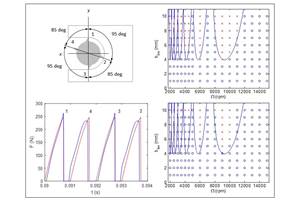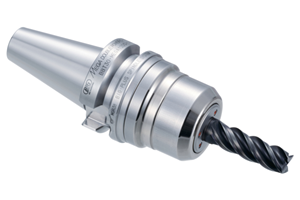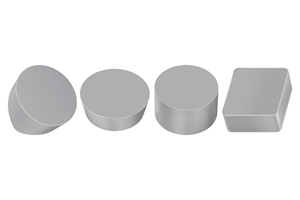Fine Pitch Cutter Increases Milling Productivity
This 120 year-old manufacturer to update its manufacturing processes and expand its product offering so it could become a sole-source supplier for its customers in the steam industry.
Share




In nearly every phase of life tradition does battle with "what have you done for me lately?" Watson McDaniel Company of Norristown, Pennsylvania, began 120 years ago as one of the first manufacturers of steam traps, pressure regulators and other steam specialty products. The company has since earned a solid reputation by consistently following its founders' guide: "To produce well-engineered products of high quality, designed to render a maximum of service with a minimum of maintenance."
When manufacturing engineer Dave Bridi joined the company about four years ago, Watson McDaniel was working with early CNC machining centers and turning centers as well as some manual machine tools. At that time, operations vice-president Bob Hickey saw the effects of growing competitive pressure.
Mr. Hickey knew the company needed to update its manufacturing processes and expand its product offering so it could become a sole-source supplier for its customers in the steam industry. "We want to provide our customers and distributors with one-stop shopping," he said. "They can come to one company and buy everything they need."
The first step in the evolution of the Watson McDaniel tradition was optimizing manufacturing operations. In analyzing the way a part is made, Mr. Bridi says he first looks at how many times the work is handled, carrying out as many operations as possible in a single setup.
Another step included the company-approved purchase of a horizontal machining center (HMC).
The capabilities of the machining center enable Watson McDaniel to make best use of its skilled employees. "We're not trying to become a robotic manufacturing facility without any employees," Mr. Bridi says, "but with the CNC machining center we can capture the skills of a machinist and keep the ball in our court." This means that simple, large part runs can occur during off hours. Minimally-tended CNC machining also frees the machinist to load pallets or maintain tooling while his job runs on its own.
Mr. Bridi uses CNC programs even for very small part runs. As an example he described one "production run" of only two a year—a "fairly big and complicated valve." "By the time you set the machine up and did all the drilling and tapping, you were at two days for the two parts," he said. "I invested four hours programming, fixturing, and running the first part. Then it was a thirty-minute cycle. So the first time I did two days worth of work in five hours. Now, even if you count on two hours for a setup, you'll get the two parts off in two thirty-minute cycles, so now it's three hours to get you two parts, versus two days," Mr. Bridi said.
As part of its effort to get the most out of its investment in advanced equipment, Watson McDaniel continually looks for ways to boost productivity by upgrading tooling. Previously, tooling was purchased sporadically from a variety of suppliers. Now a more organized approach is taken, including consideration of a supplier's abilities to offer technical support and provide a comprehensive tooling selection. This method provides benefits both in machining productivity and in consolidation of procurement costs.
One example of a simple tooling change that increased machining productivity involved a milling operation on class 25-30 cast-iron valve body. Watson McDaniel has been performing the operation at 850 sfm and 60 ipm feed with a 4-inch diameter 45-degree shear angle milling cutter tooled with four cermet inserts. An attempt to boost productivity by raising the feed rate produced chatter. On the advice of Kennametal (Latrobe, Pennsylvania) machining systems engineer Rick Doerr, Mr. Bridi upgraded the fixturing and replaced the cutter with a fine pitch "automotive" cutter from Kennametal Hertel. The cutter had 16 inserts in the CH2 alumina/TiCN/TiN-coated carbide grade. The CH2 grade offers the high wear resistance necessary for high-speed machining of abrasive materials like cast iron.
Mr. Bridi says the cutter is a good design for this job: "The fine pitch allows you to increase the feed rate because you have more inserts cutting" and its positive radial rake and negative axial rake also helps eliminate chatter. Mr. Bridi—who says his shop background prompts him to go for maximum performance—found he could triple the feed rate to 180 ipm with the new cutter and fixturing. But the impressive feed had its price; tool life was about 300 or 400 parts before indexing was necessary. "But the parts come off the machine pretty quick." he said, "When I dropped the feed to 120 ipm, the tool life goes to 500 to 700 parts, nearly double." Mr. Bridi also found that the lower feed enabled him to eliminate a finish pass that had been necessary at the higher feed rate.
The "new tradition" at Watson McDaniel might be summed up as constant adaptation to meet the needs of its customers. "Our customers are driving our new products," Mr. Hickey said, "What they ask for is what we make." MMS
Related Content
The Impact of Cutting Teeth Spacing on Machining Stability
Many cutter designs are available, and variable teeth spacing (or variable pitch) cutters can be used to influence milling stability. Let’s discuss why teeth spacing affects stability.
Read MoreBig Daishowa Chuck Eliminates Chatter in Milling Operations
The Mega 12DS chuck is designed for trochoidal milling with anti-vibration end mills.
Read MoreWalter Ceramic Inserts Enable Efficient Turning, Milling
Suitable turning and milling applications of the WIS30 ceramic grade include roughing, semi-finishing and finishing, as well as interrupted cuts.
Read MoreKennametal's Expanded Tooling Portfolio Improves Performance
The company has launch eight new products that expand on and support existing platforms across multiple applications.
Read MoreRead Next
Building Out a Foundation for Student Machinists
Autodesk and Haas have teamed up to produce an introductory course for students that covers the basics of CAD, CAM and CNC while providing them with a portfolio part.
Read MoreRegistration Now Open for the Precision Machining Technology Show (PMTS) 2025
The precision machining industry’s premier event returns to Cleveland, OH, April 1-3.
Read MoreSetting Up the Building Blocks for a Digital Factory
Woodward Inc. spent over a year developing an API to connect machines to its digital factory. Caron Engineering’s MiConnect has cut most of this process while also granting the shop greater access to machine information.
Read More




















.jpg;maxWidth=300;quality=90)













